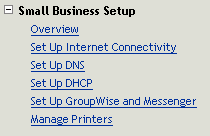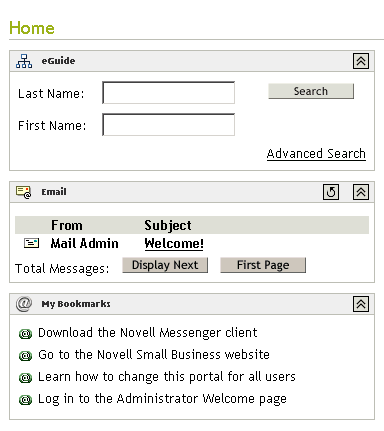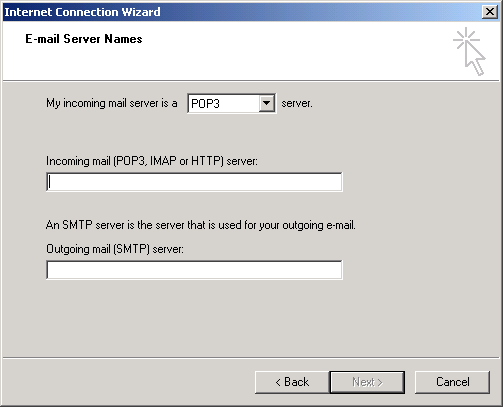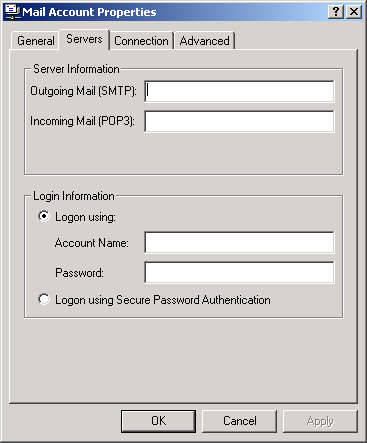Setting Up Your Initial GroupWise System
The Small Business Suite provides an easy process for getting e-mail up and running quickly.
- Creating Your GroupWise System
- Creating GroupWise Accounts for Users
- Accessing GroupWise Mailboxes
- Setting Up Common Mailbox Forwarding with the POP Forwarding Agent
- Sending and Receiving Instant Messages
Creating Your GroupWise System
If you are setting up GroupWise on a single server, using the Set Up GroupWise and Messenger task in iManager rather than the GroupWise CDs to perform the installation cuts the setup time from 30 minutes to about five minutes and still gives you most of the control that you would have during a custom GroupWise installation. However, if you have a multiserver environment or if you would prefer to use the GroupWise CDs to perform a standard GroupWise installation, follow the instructions in the GroupWise 6.5 Installation Guide available in the GroupWise 6.5 Documentation Web page..
Prerequisites
To create your initial GroupWise system using iManager, you must have the following information on hand:
- The admin name and password for your Small Business server
IMPORTANT: If your Small Business system does not have a static external IP address, review Setting Up Common Mailbox Forwarding with the POP Forwarding Agent for background information that applies only to this particular configuration. If at all possible, you should configure your Small Business system with a static external IP address.
- The volume where you want the GroupWise domain and post office to be created
- The Internet domain name where you want to receive e-mail if e-mail connectivity to the Internet is desired
- The components you want to install:
- Basic GroupWise system (one domain with its Message Transfer Agent and one post office with its Post Office Agent)
The domain functions as the main administrative unit for your GroupWise system. The post office serves as an administrative unit for a group of users and contains users' mailboxes. Each GroupWise user has an address that consists of a user ID, the user's post office name, the GroupWise domain name and, optionally, an Internet domain name.
- Automatic creation of GroupWise users and groups based on Novell eDirectoryTM (Small Business Agent)
The Small Business Agent automatically creates GroupWise user accounts for all eDirectory users when you set up your GroupWise system. It also automatically creates GroupWise distribution lists for all eDirectory groups. Thereafter, it adds or deletes GroupWise user accounts and distribution lists whenever you add or delete eDirectory users and groups.
- E-mail connectivity to the Internet (Internet Agent)
The Internet Agent allows communication between GroupWise users and users of other messaging systems who use the Internet to send e-mail. It also allows users to user POP and IMAP e-mail clients to access their GroupWise mailboxes.
- Browser-based access to mailboxes (WebAccess)
WebAccess enables access to GroupWise mailboxes through Web browsers, WAP-enabled wireless telephones, Palm OS* devices, and Windows CE devices. WebAccess, when used on a computer's Web browser, provides most of the functionality available in the GroupWise client for Windows. Functionality on other devices is more limited.
- Instant messaging (GroupWise Messenger)
Messenger is a corporate instant messaging product that is based on eDirectory. It enables users to send instant messages in a secure environment that includes user authentication through eDirectory and SSL encryption of instant messages.
- Common mailbox forwarding (POP Forwarding Agent)
If you have a corporate POP account, the POP Forwarding Agent can be used to transfer the e-mail from your corporate POP mailbox into your GroupWise system for delivery to individual recipients. In addition, the POP Forwarding Agent can forward messages from users' personal POP mailboxes into your GroupWise system.
- Basic GroupWise system (one domain with its Message Transfer Agent and one post office with its Post Office Agent)
NOTE: GroupWise document management cannot be set up using the Set Up GroupWise and Messenger task.
Procedure
To use this streamlined method for installing your initial GroupWise system:
-
Open Novell iManager.
http://hostname_or_IP_address/nps/iManager.html
-
Log in by providing an eDirectory username and password that has sufficient rights to perform the Small Business Suite tasks.
-
In the left panel, click Small Business Setup.

IMPORTANT: Do not use this task to update an existing GroupWise system. See Updating an Existing GroupWise System.
-
Click Set Up GroupWise and Messenger.
-
Review the background information presented on each page, provide any requested information, then click Next to continue.
After you have provided the requested information, the setup task lets you modify your choices and customize a variety of configuration settings, if needed, before performing the installation.

-
(Conditional) If necessary, click Modify to refine the configuration of your GroupWise system and then click OK to return to the Configuration Summary page.
-
Click Finish on the Configuration Summary page to create your initial GroupWise system.
The setup task creates a response file from the configuration information provided, then runs the standard GroupWise Installation programs. A number of messages display on the screen, indicating progress. The process can take from five to ten minutes. When your GroupWise system has been created, you return to iManager.

-
Click Restart Server to restart the NetWare server and start the GroupWise agents.
Continue with the next section Creating GroupWise Accounts for Users.
Creating GroupWise Accounts for Users
If, during the setup task, you selected Automatic Creation of GroupWise Users and Groups Based on eDirectory, the setup task started the Small Business Agent (SBA). The SBA automatically creates GroupWise user accounts in the initial post office for all eDirectory users and enables LDAP authentication so that users can specify their eDirectory passwords in order to access their GroupWise mailboxes. If you did not select this option, then you must create GroupWise user accounts manually. See Creating GroupWise Accounts Manually.
The SBA displays an agent console on the NetWare server where it runs. At the SBA console, the SBA displays messages informing you of the GroupWise accounts it is creating and other activities it is performing. By default, the SBA scans eDirectory every five minutes for new eDirectory User objects that need accompanying GroupWise accounts and for Group objects that need corresponding distribution lists. To cause it to scan immediately, press F4 at the SBA console. The SBA also automatically creates GroupWise distribution lists for all eDirectory groups. For more information about the SBA, see Managing the Small Business Agent.
When you create new eDirectory users or groups in iManager and you rely on the SBA to create the corresponding GroupWise accounts or distribution lists, it might take up to five minutes for the GroupWise accounts or distribution lists to be available. At the SBA console, press F4 to create the GroupWise accounts or distribution lists immediately.
When your users all have GroupWise accounts, continue with the next section, "Accessing GroupWise Mailboxes."
Accessing GroupWise Mailboxes
After the GroupWise agents are running and users have GroupWise accounts set up, users can access their GroupWise mailboxes in a variety of ways:
- Using the GroupWise Windows Client
- Using the GroupWise WebAccess Client
- Using Virtual Office
- Using a Third-Party E-mail Client
- Using Microsoft Outlook
Using the GroupWise Windows Client
The GroupWise Windows client is ideal for e-mail, calendaring, scheduling, and much more in the office environment. The GroupWise Windows client software must be installed on each user's workstation. You have several options for distributing the GroupWise client software to users:
- Make copies of the GroupWise 6.5.4 Windows Client CD and give them to users. The client Installation program is located at the root of the CD.
- Have users map a drive to sys:\grpwise\software\client\win32 directory on your Small Business server. The client Installation program is located in the win32 directory.
- Use one of the more sophisticated installation methods described in the Client section of the GroupWise 6.5 Administration Guide in the GroupWise 6.5 online documentation.
The following procedure assumes that users have the GroupWise 6.5.4 Windows Client CDs or have mapped a drive.
-
Make sure you are logged in as yourself on your workstation.
-
Click Start > Run, browse to the location of setup.exe on the GroupWise 6.5.4 Windows Client CD or mapped drive, select setup.exe, then click OK.
-
Follow the instructions in the Setup Wizard to install the Windows client software on your workstation.
Immediately after installation, the client Installation program offers you the opportunity to start the GroupWise client. It also places an icon on your desktop to use when starting GroupWise in the future.
For assistance in learning to use the GroupWise Windows client, click Help. Also see the GroupWise 6.5 Windows Client User Guide on the GroupWise 6.5 Documentation Web page.
Using the GroupWise WebAccess Client
The GroupWise WebAccess client allows users to access their GroupWise mailboxes from a Web browser on the road, in the office, or at home. The WebAccess Agent and a Web server must be running on your Small Business server in order for WebAccess to be available to GroupWise users. You must give the users the IP address or hostname of your Small Business server in order for them to use WebAccess. Then give them the following instructions:
-
In the Address field of a browser window, go to the following URL:
http://ip_address_or_hostname/servlet/webacc
The WebAccess Login page appears.
-
Save this URL as a bookmark.
-
Provide the username and password associated with your GroupWise mailbox.
If you chose to automatically create users as described in Creating GroupWise Accounts for Users, LDAP authentication was enabled so that you can provide your eDirectory password in order to access your GroupWise mailbox. No separate mailbox password is required.
-
Click Login to log in to GroupWise WebAccess.
For assistance in learning to use the GroupWise Windows client, click Help. Also see the GroupWise 6.5 WebAccess Client User Guide on the GroupWise 6.5 Documentation Web page.
Using Virtual Office
If you have installed Virtual Office during your Small Business server installation, users can access their e-mail from the main Virtual Office Home page. The e-mail section of the Virtual Office Home page provides a quick view of the most recent messages.

Users can click the E-mail button in the middle of the page to use WebAccess to work in their GroupWise mailboxes.
Using a Third-Party E-mail Client
If your users are familiar with a common third-party POP or IMAP e-mail client such as Outlook Express that comes with Windows, they can continue to use it to access their GroupWise mailboxes. Users of third-party e-mail clients retain the feature sets of their familiar e-mail clients, but the many GroupWise features that are not offered in POP and IMAP e-mail clients are not available to such users.
The GroupWise Internet Agent is required in order for users to access their mailboxes using third-party e-mail clients. If you have not already installed the Internet Agent, follow the instructions in the GroupWise 6.5 Installation Guide available in the GroupWise 6.5 online documentation.
In order for users to access their GroupWise mailboxes from a third-party e-mail client, they must configure their e-mail clients to access their GroupWise accounts. For example, Outlook Express users would follow steps similar to the following:
NOTE: Steps might vary depending on the versions of Windows and Outlook Express installed on the workstation.
-
In Outlook Express, click Tools > Accounts > Add > Mail.
-
Follow the prompts and provide personal information until you are prompted for the e-mail server information.

-
Select POP3 or IMAP as your incoming mail server type.
-
In the Incoming and Outgoing Mail fields, specify the IP address or hostname of your Small Business server and then click Next.
-
Continue following the prompts and providing personal information until the new account has been set up in Outlook Express.
-
Click Tools > Accounts.
-
Select the new account you just created, then click Properties > Servers.

-
Select My Server Requires Authentication, then click OK.
The default setting for this option is Use Same Settings as My Incoming Mail Server, so you do not need to change any settings.
-
To access your GroupWise mailbox in Outlook Express, click Tools > Send and Receive.
-
Click the IP address or hostname of your Small Business server.
-
Provide your username and password, then click OK.
Using Microsoft Outlook
If your users have been using the Microsoft Outlook e-mail client that comes standard with Microsoft Office, they can continue to use it to access their GroupWise mailboxes. However, not all GroupWise functionality will be available in Outlook.
In order for users to access their GroupWise mailboxes from Outlook, they must configure Windows to access their GroupWise accounts. For example, Outlook users would follow steps similar to the following.
NOTE: Steps might vary depending on the versions of Windows and Outlook installed on the workstation.
-
On the Windows Control Panel, click Mail and Fax.
The default profile is displayed.
-
Click Show Profiles > Add to add a new profile for your GroupWise account.
-
Select Internet E-Mail, then follow the prompts and provide personal information until you reach the Servers property page.

-
In the Outgoing Mail and Incoming Mail fields, specify the IP address or hostname of your Small Business server.
-
In the Account Name and Password fields, specify your GroupWise user ID and password.
IMPORTANT: Do not select Logon Using Secure Password Authentication.
-
Continue providing information on the Connection and Advanced property pages as needed, then click OK to save the mail account information.
-
Continue following the prompts and providing personal information until the new account has been set up.
-
To access your GroupWise mailbox in Outlook, click Tools > Check for New Mail On, then select the mail service that you set up from the Control Panel.
-
Provide your username and password, then click OK.
Setting Up Common Mailbox Forwarding with the POP Forwarding Agent
Ideally, a GroupWise system is installed and running in a system that has a static external IP address and is always connected to the Internet. As a result, the IP address and Internet domain name established for the GroupWise system are always available to the DNS servers across the Internet.
If your company does not have a static external IP address or your system is not always connected to the Internet, you can set up common mailbox forwarding as a simple, low-cost alternative to hosting your own domain. Common mailbox forwarding enables you to connect to the Internet using dynamic DSL, cable modem telephone dial-up, or other generally available Internet access methods to receive e-mail.
- Setting Up Your Common Mailbox
- Understanding the POP Forwarding Agent
- Setting Up Common Mailbox Forwarding and the POP Forwarding Agent
- Testing the POP Forwarding Agent
For more information about the POP Forwarding Agent, see Managing the POP Forwarding Agent.
Setting Up Your Common Mailbox
-
Obtain a POP e-mail account.
Typically, a POP account is part of the basic Internet connectivity offered by your Internet Service Provider (ISP). You might want to have your ISP host not only your e-mail but also your company Web site. Before configuring your system for common mailbox forwarding, verify that your service agreement with your ISP authorizes such use of your Internet connection.
-
Register an Internet domain name.
A large number of Internet domain registry services are available that can, for a small fee, register the domain name of your choosing and allow you to redirect HTTP and e-mail requests to your ISP Web sit and e-mail account.
-
Configure e-mail forwarding.
You domain service must be configured so that e-mail addressed to any user at your domain name goes into your common mailbox established in Step 1.
-
Configure common mailbox forwarding.
Step 1 through Step 3 were performed by other organizations. The final step must be performed by you on your Small Business server by completing the instructions in the following sections.
Understanding the POP Forwarding Agent
When you perform the Set Up GroupWise and Messenger task in iManager and Select Common Mailbox Forwarding, you choose to have the POP Forwarding Agent (PFA) installed and started for you. The PFA periodically checks the corporate POP mailbox that your ISP set up and downloads any waiting e-mail into your GroupWise system. The PFA also removes downloaded e-mail from the common mailbox. The GroupWise Internet Agent then processes the incoming e-mail, routing messages to GroupWise mailboxes based on the specific recipient information for each message. By default, e-mail is retrieved every 30 minutes; you can adjust the interval as needed, as described in Viewing or Changing the PFA Schedule.
The PFA retrieves e-mail from the common POP mailbox, but it does not send e-mail. Outgoing e-mail always goes through the Internet Agent. Using the Set Up GroupWise and Messenger task in iManager, you provide the Internet domain name for the Internet Agent to use. The Internet Agent must be configured with the same domain name as you are using for domain name forwarding so that replies to messages you send arrive in the common POP mailbox.
The PFA is not part of the GroupWise product but is integrated with it to perform common mailbox forwarding in environments where a static IP address and uninterrupted Internet connectivity are not available.
Setting Up Common Mailbox Forwarding and the POP Forwarding Agent
You can use the Set Up GroupWise and Messenger task in iManager to install the PFA, even if you have already installed your GroupWise system in iManager or by using the GroupWise CDs.
-
Open iManager and select the Set Up GroupWise and Messenger task. For more information, see Creating Your GroupWise System.
-
On the GroupWise and Messenger System Configuration page, select Enable Common Mailbox Forwarding (POP Forwarding Agent) and Set Up E-Mail Connectivity to the Internet (Internet Agent).
-
Deselect all other components.
-
Continue through the task as prompted.
-
When installation is complete, reboot your Small Business server.
The PFA starts when your server restarts.
Continue with Testing the POP Forwarding Agent.
Testing the POP Forwarding Agent
After you have set up the PFA to forward mail into the GroupWise system, send messages to any of the POP accounts and domain names that you have set up. The messages should arrive in the GroupWise mailboxes of the recipients they are addressed to. Undeliverable messages are automatically sent to the Postmaster for the Internet Agent. If you have not yet set up a Postmaster, see Assigning a Postmaster.
Sending and Receiving Instant Messages
In order for users to send instant messages, they must install GroupWise Messenger on their workstations.
-
Access the Novell Messenger Welcome page by entering the following URL in your browser address field:
http://ip_address_or_hostname:8300
-
Click the Novell Messenger link, then continue following the instructions on the Welcome page to install and start Messenger.
-
Click Help for assistance in learning to use the Messenger client.
For administrative information about your Messenger system, see the Messenger 1.0 Administration Guide in the GroupWise 6.5 online documentation.